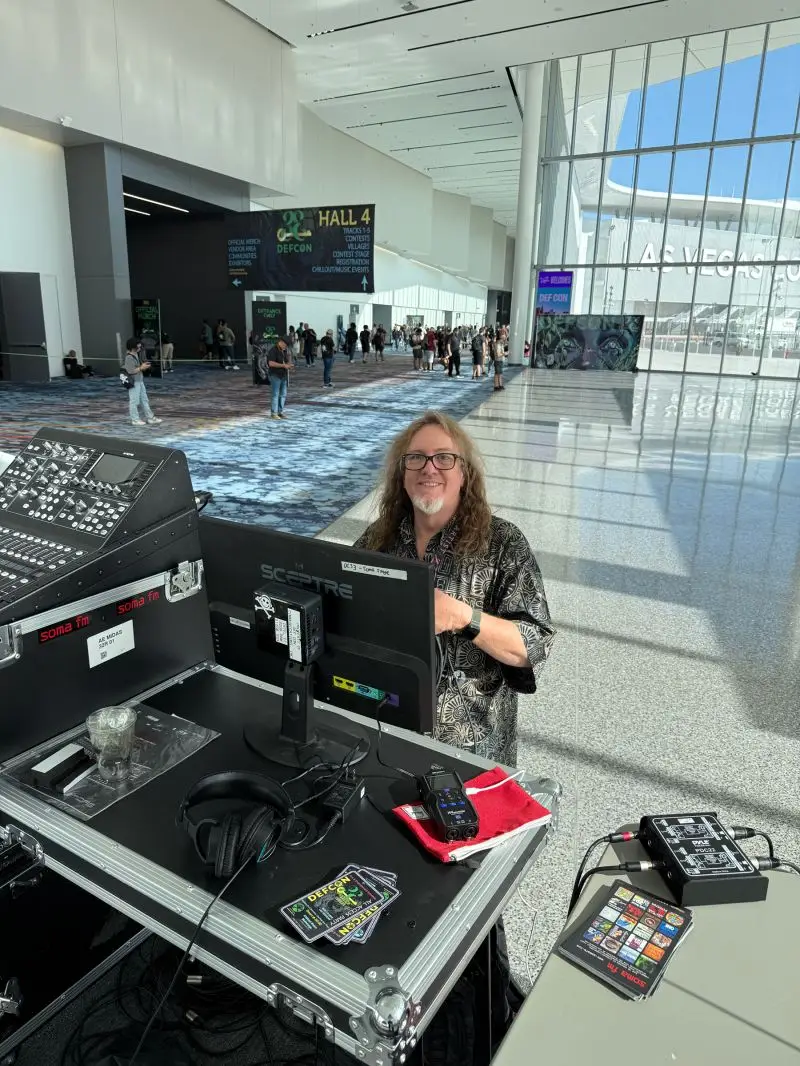
In the early days of the internet revolution, when most people were still discovering the possibilities of the World Wide Web, a software developer named Rusty Hodge was already envisioning the future of radio broadcasting. From a modest basement garage in San Francisco’s Bernal Heights neighborhood, Hodge launched what would become one of the internet’s most enduring and influential radio networks: SomaFM. Now celebrating its 25th anniversary in 2025, SomaFM has evolved from a single micropower radio station into a globally respected network of over 30 commercial-free channels, proving that independent, listener-supported broadcasting can not only survive but thrive in the digital age.
Origins: From Burning Man to Global Phenomenon
SomaFM’s story begins in 1999 at the Burning Man Festival in Nevada’s Black Rock Desert, where Hodge brought transmitters to provide ambient music for the gathering. What started as an experiment to enhance the festival experience became something much larger when the response proved overwhelmingly positive. The temporary broadcast was so successful that Hodge decided to launch SomaFM as a full-time internet radio station in February 2000.
The name itself reflects both the station’s philosophical underpinnings and geographical roots. “Soma” references the “perfect pleasure drug” from Aldous Huxley’s dystopian novel Brave New World, while “FM” acknowledges radio’s traditional format even as it embraces the internet’s borderless possibilities. The secondary reference to San Francisco’s South of Market (SoMa) neighborhood grounds the station in its urban origins while suggesting the broader cultural landscape it would come to represent.
From the beginning, SomaFM positioned itself as “listener-supported, commercial-free, underground/alternative” radio, rejecting the advertising-driven model that dominated traditional broadcasting. This philosophical stance wasn’t just aesthetic it was practical, allowing the station to program music based purely on artistic merit rather than commercial viability. As Hodge explained in 2004, “We’re never really going to have a Top 40 station”, a commitment that has remained constant throughout the station’s evolution.
The Digital Millennium Copyright Crisis
SomaFM’s early years were marked by a near-fatal encounter with copyright legislation that threatened the entire internet radio industry. In May 2002, the Digital Millennium Copyright Act’s Copyright Arbitration Royalty Panel ruling went into effect, requiring internet broadcasters to pay per-song, per-listener royalties to SoundExchange retroactively through October 1998. For SomaFM, with its growing audience of up to 10,000 concurrent listeners, Hodge estimated potential costs exceeding $1,000 per day far more than the station’s modest donation-based revenue could support
The financial impossibility forced SomaFM to cease broadcasting in June 2002, joining numerous other internet radio stations that couldn’t afford the new royalty structure. However, Hodge didn’t accept defeat quietly. He became one of several webcasters who testified before the U.S. Congress in 2002, arguing that the recording industry’s royalty demands were destroying the very platforms that were introducing listeners to new music.
The advocacy proved successful when Congress passed the Small Webcaster Settlement Act of 2002 in November, enabling small webcasters to negotiate lower royalty rates with SoundExchange. SomaFM resumed broadcasting in late November 2002 under this new structure, paying approximately $2,000 per year in royalties a manageable amount that allowed the station to continue operating while compensating artists for their work.
Channel Development and Musical Philosophy
What distinguished SomaFM from other internet radio ventures was Hodge’s curatorial approach to programming. Rather than simply playing popular music or following genre formulas, each channel reflected specific aesthetic visions that often-blended multiple styles while maintaining coherent identity. The flagship Groove Salad channel exemplified this approach, serving what the station described as “a nicely chilled plate of ambient/downtempo beats and grooves” instrumental electronic music perfect for work or relaxation.
Secret Agent emerged as another signature channel, offering “the soundtrack for your stylish, mysterious, dangerous life” through “an eclectic blend of cinematic downtempo, stylish lounge, sambas and easy-tempo with an adventurous flair”. The channel’s success demonstrated how internet radio could create entirely new listening contexts, encouraging listeners to imagine themselves in film noir scenarios while going about their daily routines.
Drone Zone, born directly from the original Burning Man broadcasts, provided “atmospheric textures with minimal beats” for listeners seeking deeper ambient experiences. The channel became a destination for meditation, concentration, and late-night listening, proving that even the most experimental music could find dedicated audiences when presented with appropriate context.
Other notable channels included Beat Blender, featuring more rhythmic electronic music; Space Station Soma, focusing on ambient and space music; Lush, celebrating electronic music with female vocals; and Fluid, specializing in “instrumental hip-hop, future soul and liquid trap”. Each channel maintained distinct personality while contributing to SomaFM’s overall aesthetic of sophisticated, non-commercial music curation.
Technical Innovation and Mobile Adaptation
SomaFM consistently pioneered technical innovations that enhanced internet radio listening experiences. In 2005, the station partnered with Orban to begin streaming to 3GPP-compatible mobile devices, becoming one of the first internet broadcasters to support mobile streaming on 3G/EDGE networks. This early mobile adoption positioned SomaFM ahead of the smartphone revolution that would transform music consumption.
The station’s technical infrastructure, initially running from Hodge’s garage using 15 servers tucked into corners, eventually expanded to professional data center hosting near San Francisco’s Financial District. The music playout systems utilize Windows XP computers with Orban 1100/1101e DSP/Audio Processing boards, while stream servers run Linux (mostly Ubuntu). This hybrid approach balances stability with cost-effectiveness, allowing SomaFM to deliver professional-quality broadcasts without major-label budgets.
Recent technical developments include CD Quality FLAC HLS test streams using StreamS encoders, offering lossless audio quality through HTTP Live Streaming (HLS) technology. The Groove Salad channel’s FLAC stream demonstrates SomaFM’s commitment to audio quality while exploring new streaming technologies that could benefit the entire internet radio industry.
Artist Relations and Music Discovery
SomaFM’s influence on music discovery and artist promotion has been substantial throughout its history. The station’s collection of over 10,000 CDs provides extensive programming material without repetition, while the practice of logging all played tracks on the website creates permanent records of broadcast history. This transparency helps listeners discover new music while providing artists with documentation of their airplay.
Major and independent labels began sending music to SomaFM once its influence became apparent, understanding that “having a song played there” could significantly impact an artist’s career. However, Hodge maintained strict curatorial standards, explaining that while “a lot of the bigger stations want to send us stuff… it doesn’t really fit” with SomaFM’s aesthetic vision.
The station’s global reach proved particularly valuable for electronic music artists, many of whom were creating music that didn’t fit traditional radio formats. SomaFM’s channels provided dedicated platforms for ambient, downtempo, trip-hop, and experimental electronic music that commercial radio largely ignored. Artists whose work appeared regularly on SomaFM channels included Kosma, the Sneaker Pimps, Charles Webster, Amon Tobin, Woob, Devotion, Kid Loco, Groove Armada, and the Starseeds.
Global Community and Cultural Impact
By the mid-2000s, SomaFM had developed a truly international audience, with listeners connecting from Japan, Europe, and throughout the United States. The station’s peak listening times occurred at 3 AM Pacific Time when “the Far East was at work”, creating what Hodge described as “the opposite of drive time… sitting-at-your-desk time”.
This global community demonstrated internet radio’s ability to create shared cultural experiences across geographical boundaries. The station’s specialized programming created virtual gathering spaces for electronic music enthusiasts who might never meet physically but shared aesthetic preferences and listening habits. Reddit communities dedicated to genres like trip-hop consistently recommend SomaFM channels, indicating the station’s ongoing relevance to contemporary music discovery.
The cultural impact extended beyond music to influence work and lifestyle patterns. Many listeners adopted SomaFM as essential background music for concentration and productivity, with channels like Groove Salad becoming synonymous with creative work environments. The station’s “no lyrics, minimal beats” aesthetic proved particularly suitable for coding, design, and other creative professional activities that required sustained focus.
Business Model and Sustainability
SomaFM’s entirely donation-supported business model represented a radical experiment in media sustainability that has succeeded where many commercial ventures have failed. The station operates on the principle that listeners who value the service will voluntarily support it, avoiding both advertising revenue and subscription fees that could limit access.
Financial transparency has been key to this approach. Hodge regularly discusses the station’s costs, explaining that bandwidth expenses approach $7 per listener while royalty payments to SoundExchange consume significant portions of the budget. The station “rarely turns a profit”, with excess revenue immediately reinvested in “CDs and, more importantly, bandwidth”.
The donation model creates direct relationships between listeners and the station, encouraging community investment in SomaFM’s continued operation. Merchandise sales through an online store supplement donation revenue while allowing supporters to display their allegiance to independent radio. This approach has proven remarkably durable, sustaining the station through economic downturns and industry changes that have eliminated many commercial radio operations.
COVID-19 Impact and Adaptation
The COVID-19 pandemic significantly impacted the music industry, with live music and physical retail segments hardest hit. However, internet radio experienced increased listenership as people spent more time at home and sought audio entertainment that complemented remote work. Spotify gained six million subscribers in the first quarter of 2020, suggesting broader increased demand for streaming audio services.
For SomaFM, the pandemic likely increased listenership as more people worked from home and sought the kind of concentration-friendly background music the station specialized in providing. The station’s focus on instrumental electronic music ideal for productivity aligned perfectly with the needs of remote workers seeking audio environments that enhanced rather than distracted from professional tasks.
The pandemic also highlighted the value of independent, non-commercial media as traditional revenue sources for commercial radio stations contracted. SomaFM’s listener-supported model provided stability during a period when advertising-dependent media struggled with reduced commercial spending.
Current Status and Future Developments
As of 2025, SomaFM operates over 30 year-round channels serving a global audience through multiple platforms including iOS and Android apps, web streaming, smart speakers, and traditional media players. The station’s official app provides access to all channels with features including song identification, listening history, Siri Shortcuts, AirPlay compatibility, and multiple streaming quality options.
Recent developments include 25th anniversary celebrations featuring retrospective content highlighting the station’s evolution. The milestone represents remarkable longevity for an independent internet radio venture, demonstrating that consistent artistic vision combined with technical excellence can create sustainable media businesses.youtube
High-resolution FLAC streaming experiments suggest SomaFM continues exploring technical innovations that could enhance listening experiences while potentially attracting audiophile listeners seeking superior sound quality. These developments maintain the station’s tradition of pioneering internet radio technologies while serving existing community needs.
Legacy and Influence
SomaFM’s quarter-century journey from Burning Man experiment to global radio network represents one of internet media’s great success stories. The station proved that independent, non-commercial broadcasting could not only survive but thrive online, inspiring countless imitators while maintaining its unique identity and aesthetic standards.
The station’s influence extends beyond internet radio to broader conversations about media independence, artist compensation, and cultural curation in digital environments. SomaFM demonstrated that listeners would voluntarily support media that provided genuine value, challenging assumptions about consumer behavior and media sustainability.
Perhaps most significantly, SomaFM created lasting cultural impact by providing dedicated platforms for electronic music genres that commercial radio ignored. Ambient, downtempo, trip-hop, and experimental electronic music found consistent, professional presentation through SomaFM’s channels, helping these genres develop audiences and cultural legitimacy they might not have achieved otherwise.
The Continuing Experiment
As SomaFM enters its second quarter-century, the station faces both opportunities and challenges that will test the durability of its foundational principles. Streaming music services offer convenience and vast catalogs, while podcast platforms provide on-demand content that internet radio cannot match. However, SomaFM’s curated, continuous programming offers experiences that algorithmic playlists and user-generated content cannot replicate.
The station’s commitment to “staying true to the music” while continuing to grow remains its defining challenge and greatest strength. In an era of increasing media consolidation and algorithm-driven content, SomaFM’s human-curated programming represents authentic alternative approaches to audio entertainment and cultural curation.
From Rusty Hodge’s garage in Bernal Heights to a global network serving hundreds of thousands of listeners, SomaFM’s evolution demonstrates that independent media can achieve remarkable reach and influence when guided by clear artistic vision and sustained by genuine community support. As the station continues broadcasting 24 hours a day, every day, from a garage to the world, it stands as proof that the internet’s early promises of democratized media and global community building were not just utopian dreams but achievable realities for those willing to commit to the long-term work of building authentic cultural institutions.
The success of SomaFM offers hope for independent media creators while serving as a model for sustainable, community-supported cultural programming that prioritizes artistic integrity over commercial considerations. In celebrating its 25th anniversary, SomaFM celebrates not just its own survival but the possibility that independent, authentic media can continue flourishing in an increasingly commercialized digital landscape.
SomaFM: Commercial-free, Listener-supported Radio









